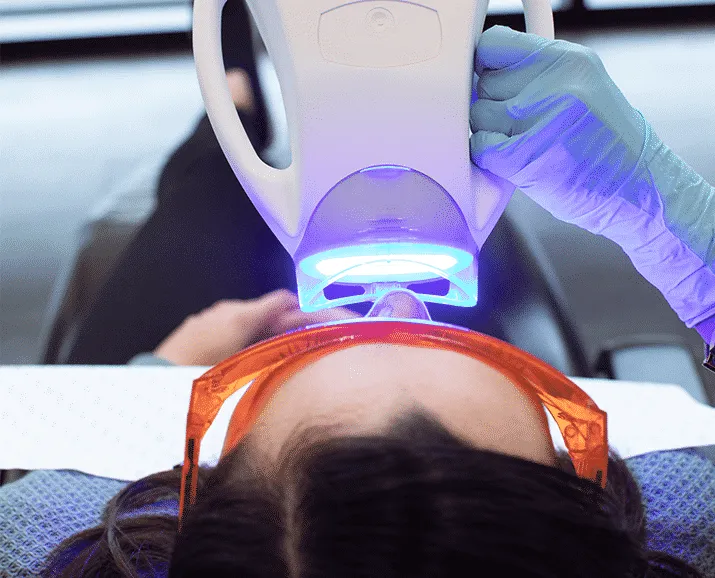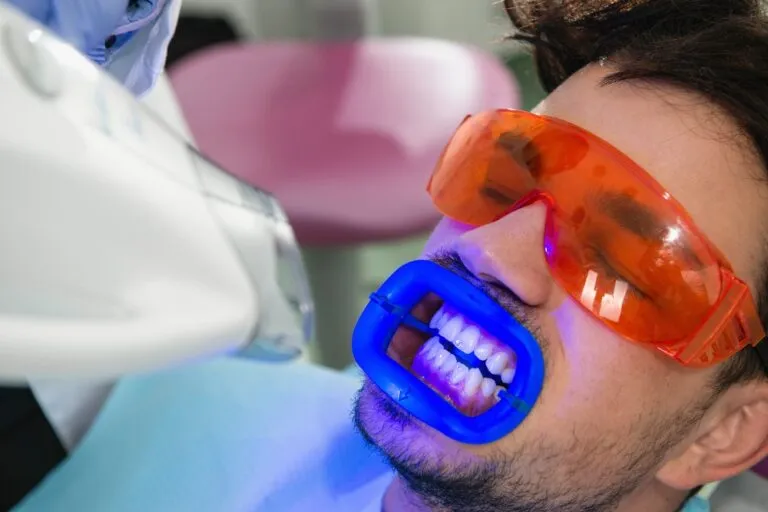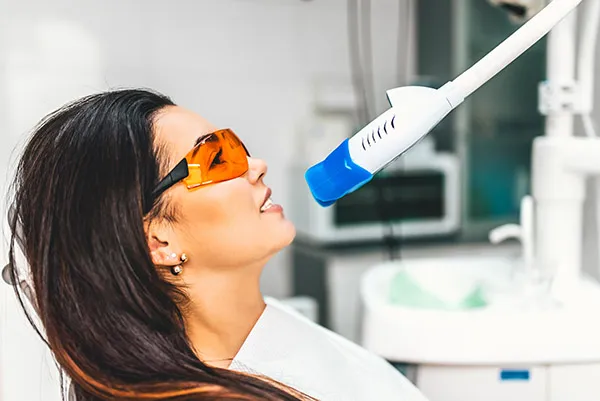What is Laser Teeth Whitening
Laser teeth whitening, also known as power whitening or in-office whitening, is a cosmetic dental procedure designed to lighten the color of your teeth. It involves the application of a bleaching agent, typically hydrogen peroxide, to the teeth, followed by the use of a laser to accelerate the whitening process. The laser emits a specific wavelength of light that activates the bleaching agent, breaking down stains and discoloration caused by factors like aging, coffee, tea, tobacco, and certain foods. This procedure is usually performed in a dentist’s office and offers a relatively quick way to achieve a brighter smile. The duration of the treatment can vary, but it typically takes about an hour, making it a convenient option for those seeking immediate results. However, it is important to understand the potential side effects and considerations before undergoing laser teeth whitening.
How Does Laser Teeth Whitening Work
The process of laser teeth whitening is fairly straightforward, but it is crucial to understand the steps involved. First, the dentist will clean your teeth and may take photos to document the initial shade. A protective barrier, such as a rubber dam, is then placed around your gums to shield them from the bleaching agent. The whitening gel, which contains a high concentration of hydrogen peroxide, is applied to the surface of your teeth. A laser is then directed at your teeth. The laser’s energy activates the whitening agent, breaking down the stains and discoloration. This process is usually repeated in multiple sessions, each lasting a few minutes. After the procedure, the dentist will remove the gel and provide aftercare instructions. The entire process is relatively quick, but it’s important to note that individual results can vary depending on the initial condition of the teeth and the type of stains present.
Common Side Effects of Laser Teeth Whitening

While laser teeth whitening is generally considered safe, it is not without potential side effects. Many individuals experience some form of sensitivity after the procedure. This can manifest as a sharp, shooting pain when consuming hot or cold foods and drinks. Gum irritation is another common issue, with symptoms including redness, swelling, and discomfort. These side effects are usually temporary, subsiding within a few days or weeks as the teeth and gums recover. However, it’s essential to be aware of these potential issues and to take appropriate measures to minimize any discomfort. Additionally, while less common, other side effects can occur, highlighting the importance of consulting with a dental professional to discuss the risks and benefits of the procedure.
Tooth Sensitivity After Laser Whitening
Tooth sensitivity is one of the most frequently reported side effects of laser teeth whitening. The bleaching agents used in the process can penetrate the enamel and reach the dentin, which contains the nerve endings. This can lead to temporary sensitivity, often experienced as sharp, shooting pains when consuming hot or cold items. The severity of the sensitivity varies from person to person. Some individuals might experience only mild discomfort, while others might feel significant pain. The duration of the sensitivity also varies; it can last a few days or several weeks. Dentists often recommend using desensitizing toothpaste, which contains ingredients that help block the nerve signals and reduce sensitivity. It’s essential to inform your dentist if you experience severe sensitivity, as they can provide guidance on managing the discomfort and ensuring your oral health.
Gum Irritation After Laser Whitening
Gum irritation is another common side effect, resulting from the bleaching agents or the protective measures used during the procedure. The gums might become red, swollen, and tender, sometimes causing discomfort or soreness. This irritation is usually a temporary reaction to the chemicals used. The dentist will take measures to protect the gums with a rubber dam, but some exposure is still possible. Using gentle oral hygiene practices, such as brushing with a soft-bristled toothbrush and avoiding aggressive flossing, can help alleviate the symptoms. Rinse the mouth with lukewarm water or a saltwater solution can also help soothe irritated gums. It is crucial to report any severe or persistent gum irritation to your dentist, as it might indicate a more serious issue or the need for adjusted treatment.
Other Potential Side Effects

Beyond the common side effects, there are other potential issues to be aware of, even if they are less frequent. It’s important to be fully informed about all the potential risks. While rare, enamel damage can occur if the bleaching agent is too strong or used improperly. Allergic reactions are also possible, although uncommon. It’s essential to communicate your health history and any known allergies to your dentist before the procedure. Knowing these less common side effects can help you make an informed decision and allow your dentist to take appropriate precautions to ensure your safety and oral health.
Enamel Damage
Enamel damage is a less common but more serious potential side effect. Overuse of strong bleaching agents or improper application can weaken the enamel, the outer protective layer of your teeth. This can lead to increased sensitivity, and make your teeth more vulnerable to decay. The risk of enamel damage is higher if you already have thin or compromised enamel. A qualified dentist will assess your teeth and ensure that the bleaching agent is used at the appropriate concentration and for the correct duration to minimize this risk. Following post-treatment care instructions, such as using fluoride toothpaste, can help remineralize your enamel and reduce the likelihood of damage. Always consult with your dentist if you notice any signs of enamel erosion or increased tooth sensitivity.
Allergic Reactions
Allergic reactions to the bleaching agents or other materials used during laser teeth whitening are relatively rare. However, it is still essential to be aware of this possibility. Symptoms of an allergic reaction can include swelling, itching, hives, or difficulty breathing. If you have a known allergy to any of the ingredients in the whitening gel, inform your dentist beforehand. During the procedure, your dentist will monitor you for any signs of an adverse reaction. If you experience any allergic symptoms after the treatment, seek immediate medical attention. In most cases, allergic reactions are mild and can be managed with medication. However, it is always better to be cautious and seek professional help if needed.
How to Minimize Side Effects

You can take several steps to minimize the potential side effects of laser teeth whitening and ensure a more comfortable experience. Choosing a qualified dentist is the most important factor. Follow the dentist’s instructions for post-treatment care precisely. This may include using desensitizing toothpaste, avoiding excessively hot or cold foods and drinks for a few days, and maintaining good oral hygiene. Applying fluoride treatments, as recommended by your dentist, can help strengthen your enamel and reduce sensitivity. If you experience any side effects, inform your dentist promptly so they can provide guidance and adjust your treatment plan if necessary. Understanding the proper aftercare can help you enjoy the benefits of a brighter smile with minimal discomfort.
Choosing a Qualified Dentist
Selecting a qualified and experienced dentist is crucial to minimize the risks associated with laser teeth whitening. A skilled dentist will thoroughly evaluate your oral health, discuss your expectations, and determine if you are a good candidate for the procedure. Look for a dentist with experience in cosmetic dentistry, specifically in laser teeth whitening. Check online reviews and ask for recommendations from friends or family. During your initial consultation, discuss the procedure, potential side effects, and post-treatment care instructions. A qualified dentist will use the appropriate techniques and materials and provide personalized advice tailored to your specific needs. Choosing the right dentist significantly impacts the safety and effectiveness of the treatment, ensuring you achieve the desired results with minimal complications.
Post-Treatment Care
Following the post-treatment instructions provided by your dentist is essential for managing any side effects and maintaining your results. Avoid consuming foods and drinks that can stain your teeth, such as coffee, tea, red wine, and dark-colored berries, for at least the first 24 to 48 hours after the procedure. Use a desensitizing toothpaste to alleviate any sensitivity. Brush your teeth gently with a soft-bristled toothbrush, and floss regularly. Regular dental check-ups and cleanings are also important to maintain your oral health and the results of the whitening treatment. Your dentist may also recommend at-home maintenance products, such as whitening toothpaste or touch-up kits, to keep your smile bright. Taking care of your teeth after laser whitening will help you achieve lasting results and minimize any potential side effects.
Alternatives to Laser Teeth Whitening

If you are concerned about the side effects of laser teeth whitening or if it is not suitable for you, several alternatives are available. Over-the-counter whitening products, such as whitening toothpaste, strips, and gels, offer a more gradual approach to teeth whitening. These products typically contain lower concentrations of bleaching agents and are less likely to cause sensitivity. Your dentist can also provide custom-fitted whitening trays for at-home use, allowing you to control the bleaching process. Other options include professional teeth cleaning, which can remove surface stains and improve the appearance of your teeth, and cosmetic procedures like veneers or bonding, which address more severe discoloration. Consulting your dentist will help you determine the best alternative based on your oral health, desired results, and personal preferences.
